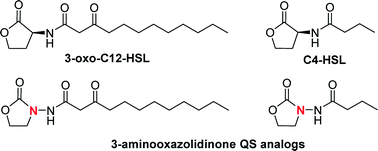3-AminooxazolidinoneAHL analogs as hydrolytically-stable quorum sensingagonists in Gram-negative bacteria†
Abstract
Synthetic molecules that modulate

* Corresponding authors
a
Department of Chemistry and Biochemistry, University of Maryland, Building 091, College Park, MD, USA
E-mail:
hsintim@umd.edu
Synthetic molecules that modulate

 Please wait while we load your content...
Something went wrong. Try again?
Please wait while we load your content...
Something went wrong. Try again?
M. Guo, Y. Zheng, R. Starks, C. Opoku-Temeng, X. Ma and H. O. Sintim, Med. Chem. Commun., 2015, 6, 1086 DOI: 10.1039/C5MD00015G
This article is licensed under a Creative Commons Attribution-NonCommercial 3.0 Unported Licence. You can use material from this article in other publications, without requesting further permission from the RSC, provided that the correct acknowledgement is given and it is not used for commercial purposes.
To request permission to reproduce material from this article in a commercial publication, please go to the Copyright Clearance Center request page.
If you are an author contributing to an RSC publication, you do not need to request permission provided correct acknowledgement is given.
If you are the author of this article, you do not need to request permission to reproduce figures and diagrams provided correct acknowledgement is given. If you want to reproduce the whole article in a third-party commercial publication (excluding your thesis/dissertation for which permission is not required) please go to the Copyright Clearance Center request page.
Read more about how to correctly acknowledge RSC content.
 Fetching data from CrossRef.
Fetching data from CrossRef.
This may take some time to load.
Loading related content
